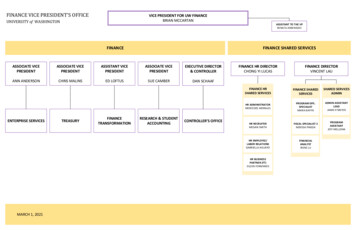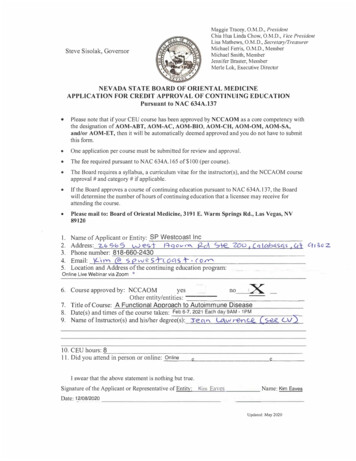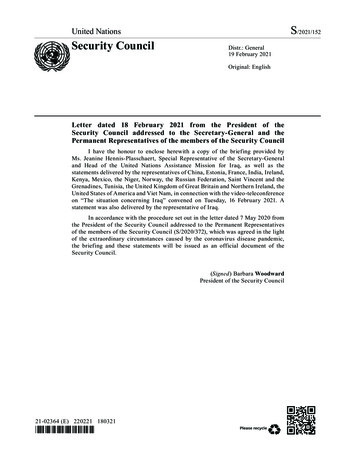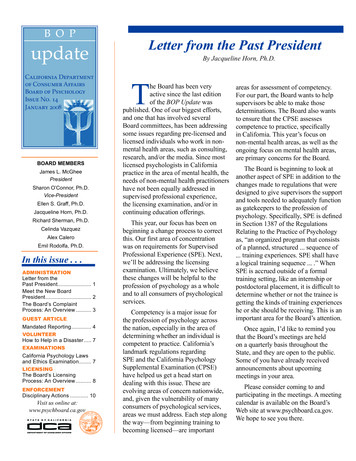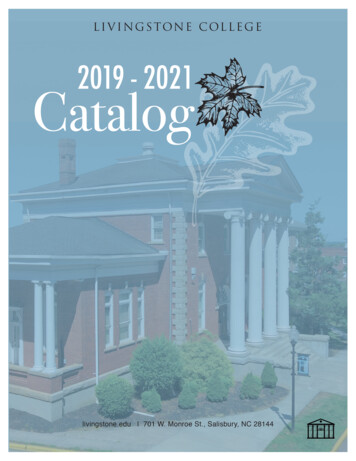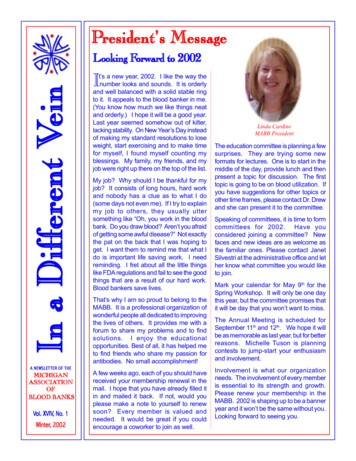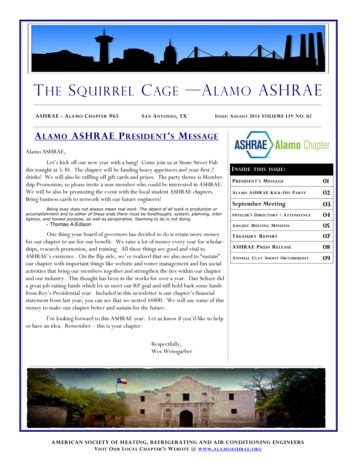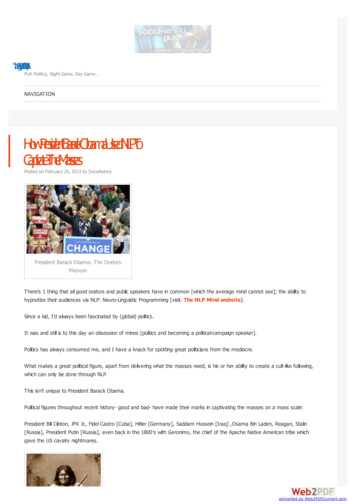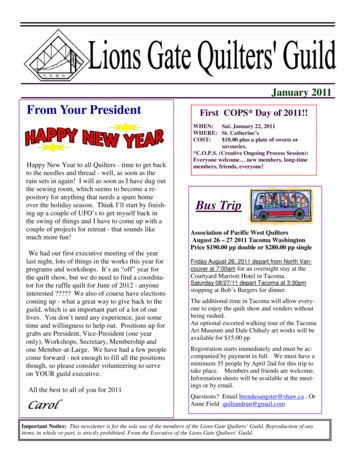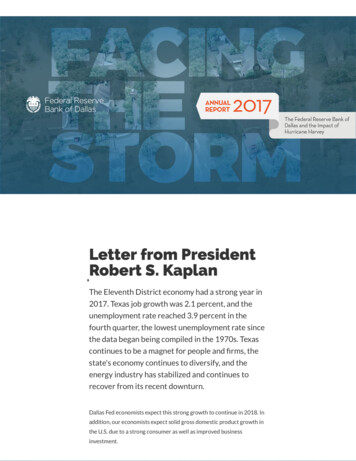
Transcription
Letter from PresidentRobert S. KaplanThe Eleventh District economy had a strong year in2017. Texas job growth was 2.1 percent, and theunemployment rate reached 3.9 percent in thefourth quarter, the lowest unemployment rate sincethe data began being compiled in the 1970s. Texascontinues to be a magnet for people and firms, thestate's economy continues to diversify, and theenergy industry has stabilized and continues torecover from its recent downturn.Dallas Fed economists expect this strong growth to continue in 2018. Inaddition, our economists expect solid gross domestic product growth inthe U.S. due to a strong consumer as well as improved businessinvestment.
Against this backdrop, our team at the Dallas Fed is focused onimproving our economic research and overall thought leadership,particularly in the areas of energy, trade and immigration. We are alsostriving to be a leading citizen in our communities by actively working onearly childhood literacy, college readiness, the digital divide, access tofinancial services and workforce development. We continue toemphasize our core operations of supervising financial institutions in ourdistrict, performing cash services, and working with other FederalReserve Banks to oversee various types of payment and Treasuryservices in our district and nation.Dallas Fed President Robert S. Kaplan thanks the Houston Branch staff for their dedicated service duringHurricane Harvey.While advancing our mission, the Dallas Fed and each of our branches,beginning in August of last year, faced a critical challenge along with ourfellow Texans: the devastating impact of Hurricane Harvey.In this annual report, we concentrate primarily on the hurricane and themyriad ways the Federal Reserve Bank of Dallas worked to serve ourcommunities before, during and after this terrible storm. We highlightthe work of our Houston Branch and key areas of our Bank, whichworked closely with state and local agencies and nonprofit andcommunity leaders to help identify and support those most affected bythis natural disaster. I am particularly proud of the performance of allour employees in the Eleventh District in responding to this tremendouschallenge.
All of us at the Dallas Fed are honored to serve our district and nation.We look forward to actively pursuing our mission in 2018 and the yearsahead.Sincerely,Robert S. Kaplan
Letter from First VicePresident Meredith N.BlackThe Federal Reserve Bank of Dallas research libraryhouses three volumes of congressional testimonydating from 1913 on the formation of the FederalReserve System. A key debate of the day waswhether to establish the new central bank as asingle centralized entity located in Washington,D.C., or as a federated organization in the form ofthe regional reserve banks that we have today. Thisdebate centered on the historical American fear ofvesting too much power in either Washington orWall Street.Ultimately, the compromise that resulted in the Federal Reserve weknow today also gave the System its greatest strength—12 federatedreserve banks working closely with the citizenry and businesses in eachregion to not only represent their economic interests in Washington, butalso meet their needs in times of crisis. We need look no further than thehurricanes that have hit the Texas Gulf Coast, the most recent occurringin August 2017, to see the value of a regional central bank system playedout in ways not imagined in 1913.After Hurricane Harvey made landfall along the Texas Gulf Coast onAug. 25, it caused widespread damage and broad disruption to theregional economy. The hurricane’s Category 4 winds and storm surgedevastated the Texas Coastal Bend area, while its record-breaking rains
brought catastrophic flooding throughout the Houston region andeastward to the Beaumont area.According to the National Hurricane Center, Harvey was the secondcostliest hurricane in U.S. history (behind Katrina), the deadliesthurricane to hit Texas since 1919 and the most significant tropicalcyclone rainfall event in U.S. history in both scope and quantity of rain.With much of the Eleventh District in the path of the storm, Dallas Fedemployees, especially at our Houston Branch, worked closely with localauthorities to meet the needs of people and businesses in affected areas.As Gulf Coast communities rebuild post-Harvey, we will continue to helpresidents and businesses address economic challenges, including accessto credit, availability of affordable housing and small-business needs. Wewill also play an ongoing role in measuring and forecasting Harvey’seconomic impact on the region and state as a whole.As chief operating officer and a 35-year employee of this Bank, I amproud of the efforts of my fellow employees to serve the citizens,businesses and financial institutions in our district. They do this on adaily basis, willingly, tirelessly and without fanfare. The actions of ouremployees in response to Hurricane Harvey highlight the value of ourregional System beyond the traditional liquidity-backstop function itperforms. I hope the five vignettes in this annual report offer a glimpseof the service we are so honored to provide.Sincerely,Meredith N. Black
Weathering Harveyby Daron PeschelHouston BranchWith its proximity to the Gulf Coast, the Houstonregion knows how to take a punch from a hurricane.But Hurricane Harvey was different—the scale andscope of the storm knocked the city down hard.For Houston, Harvey was not a storm surge or wind event like atraditional hurricane but a devastating flood event—a 1,000-year floodevent, according to some weather experts. Almost every part of theHouston region was impacted. More than 1 trillion gallons of rainwaterfell just on Harris County, according to the Harris County Flood ControlDistrict. The county is Texas’ most populous, with nearly 4.6 millionresidents.The flood control district reported that, over four days, most areas of thecounty received about a year’s worth of rainfall—between 40 and 50inches. Over 70 percent of the county had at least 18 inches of floodwater,1 and an estimated 120,000 of the county’s homes and businessesexperienced some degree of flood damage.2To prepare for the storm, the Federal Reserve Bank of Dallas’ HoustonBranch employees worked closely with local authorities and colleaguesacross the Eleventh Federal Reserve District. Activities focused on threepriorities: ensuring the safety and well-being of employees and theirfamilies, protecting the branch facility and its assets, and providingcritical services to the Houston region.
In this effort, the branch partnered with organizations that included theHouston Police Department, Harris County Office of EmergencyManagement and U.S. Secret Service to monitor conditions andcoordinate responses.Fortifications for the flood at the Houston Branch began with thebuilding itself, years before Harvey. The building sits just across thestreet from Buffalo Bayou, a major watershed in the region.The Houston Branch before and after Harvey.The facility was in the design phase during 2001 when flooding fromTropical Storm Allison devastated downtown Houston, and lessonslearned were incorporated into the branch’s final plan. The overallbuilding elevation stands above the 500-year floodplain at 50 feet abovesea level, raising critical operations out of the most vulnerable floodzone.During Hurricane Harvey, the design safeguards proved effective. Floodwatersfrom Buffalo Bayou rose up the outer perimeter wall but did not breach it. Allfacilities inside remained secure.Throughout the five-day storm, the branch housed 18 employees on-siteto provide security, monitor the building infrastructure and respond toemergency conditions around the clock. They included law enforcement,
facilities and management staff. In addition, a cadre of Cash Departmentemployees stayed at a nearby hotel to ensure staff were available tomeet the region’s financial needs.On-site staff worked 12 to 16 hours each day and slept in shifts. Severalfaced the additional challenge of remaining on duty even when their ownfamilies were forced to evacuate their homes. One employee recalls,“My wife, kids and two dogs had to leave due to a mandatory evacuationin our area. Like many, I was concerned for my family’s safety since theywere evacuating during the storm. Bank leadership checked in with meoften, and it was comforting knowing that they cared about my situationand not just the building.”With its facility secure and fully operational, the Houston Branch alsocame to the aid of a neighbor in distress. That Sunday morning, withBuffalo Bayou rising rapidly, local CBS affiliate KHOU-TV contacted thebranch to request emergency shelter for its news staff.KHOU’s building down the street was taking on water at an alarmingrate. With the station's parking garage flooded as well, 45 KHOUemployees evacuated on foot, carrying their equipment and belongingsthrough the driving rain.Houston Branch staff met the employees with carts and pickup trucks tobring them inside and set them up with work space, electrical hookups,coffee, water and lunch. When KHOU’s emergency generators failedand the station lost the ability to broadcast over the air, reportersturned to social media—streaming live from the branch to ensure thatstorm updates still went out to the Houston community.Staff from Houston CBS affiliate KHOU-TV take refuge in the Houston Branch building after their station isflooded during Hurricane Harvey.
In the months since Harvey, the Houston Branch has continued tosupport the region’s recovery, even as many of its staff members havebeen working to recover at home. One in five branch employeesexperienced some level of storm damage, with one in 10 suffering majorproperty losses.With generous support from colleagues throughout the EleventhDistrict and the Federal Reserve System, the branch has worked withemployees affected by the storm to provide financial assistance andother resources. Staff have also volunteered their time to assist withcommunity recovery efforts from a deluge that left no portion of theHouston region untouched.NOTES1. Harris County Flood Control District meteorologist Jeff Lindner,Aug. 31, 60448.2. Harris County Flood Control District, www.hcfcd.org/hurricaneharvey/.
Supplying Cashby Rick Mase and Michelle TreviñoCash ServicesAs Hurricane Harvey churned off the Texas coast,the cash team in the Dallas Fed’s Houston Branchprepared for the storm’s impact. In the week prior tolandfall, essential staff reserved hotel rooms twoblocks from the branch to ensure they would be onsite to communicate with financial institutions andsupport currency needs throughout the region.Financial institutions’ demand for cash rose sharply as the region’sresidents prepared for the storm’s onslaught and aftermath. Leading upto the storm, banks along the Gulf Coast ordered 453 million worth ofcurrency from the Houston Branch, and banks in South Texas ordered 243 million—a combined 43 percent increase compared with the sameweek in 2016.Quick and thorough communication was crucial to meet the demand forcurrency. Multiple conference calls took place daily among the EleventhDistrict’s cash management team, Federal Reserve System cash officials,financial institutions and armored carriers.The hurricane made landfall on Friday, Aug. 25, and the city of Houstonbegan to experience the effects of the storm by Saturday night. The raincontinued full force through Sunday.As the rain increased more rapidly than forecasters expected, cashorders from Central and South Texas banks that were normally handled
by the Houston Branch were rerouted to the Dallas office forprocessing.On Monday, the first business day after Harvey struck, the Houston cashteam prepared all of its cash orders for banks in the immediate GulfCoast area. However, widespread flooding prevented armored carriersfrom making it to the branch on both Monday and Tuesday.On Wednesday, as the heaviest rain shifted to the east of Houston andfloodwaters began to subside, an armored carrier successfully picked upseveral cash orders for banks. Houston cash employees who were notsignificantly impacted by the flooding also began returning to work. ByThursday, even the armored carriers servicing the Beaumont area, 85miles up the coast, were able to operate despite the rain and flooding.In the months following the storm, a new issue emerged: Banks in theGulf Coast region began depositing unusually large quantities ofcurrency soaked by floodwaters.Federal Reserve Banks are charged with ensuring the integrity of thenation’s currency by removing unfit bills from circulation. Accordingly,the Houston cash team spent countless hours handling these deposits
following a scripted process to fully account for the value of the depositand keep themselves from being exposed to potential hazards from thecurrency. About 20.4 million in contaminated currency was destroyedand replaced with bills fit for circulation to the public.
Monitoring Banksby Vince PachecoBanking SupervisionAs Hurricane Harvey approached, the Dallas Fedbegan to focus on how financial institutions wouldrespond to the storm and how the public’s access tobanking services would be impacted. Soon after thehurricane’s initial impact, the Federal Reservepartnered with other federal and state regulatoryauthorities, as well as industry representatives, on adaily basis to monitor the operating status offinancial institutions.During the first few days after landfall, it became clear the stormdamage was severe—and in some cases devastating—to manycommunities. Where the damage was so severe that it rendered banks’facilities temporarily unusable, regulatory agencies suspended priorapproval branching requirements and communicated to banks that theycould share facilities to continue serving their customers.In the storm’s aftermath, bankers worked diligently to resumeoperations, with much success. By the end of the first week, more than95 percent of all affected commercial bank branches reopened to thepublic. However, some challenges remained.The ability of banks to provide cash to their customers was a concern.Flooded roadways hampered armored carriers' access to the FederalReserve’s Houston Branch to pick up cash for delivery to their clientbanks.
Compounding the challenge, drivers for the armored carriers werefocused on their own safety and that of their families, and some werenot immediately available. The Dallas Fed issued daily communicationsto provide clarity on Federal Reserve cash services. Fortunately, bankswere prepared and resourceful and were able to meet the needs of theircustomers.As banks began to resume operations and plan long-term recovery efforts, bankersturned their attention to customers, many of whom were facing significant financialchallenges.The Federal Reserve, along with other regulatory agencies, encouragedbankers to work with affected customers and emphasized thatconsideration would be given to changes in banks’ financial conditionresulting from the hurricane. In addition, the agencies extendedflexibility to banks for filing financial reports and rescheduling bankexaminations to minimize burden during the cleanup efforts.While many will feel the effects of Harvey long into the future, financialinstitutions in the affected areas demonstrated strong resiliency andremain healthy. Good communication among the Federal Reserve,banks, other regulatory agencies and trade associations was key duringthe crisis and will continue to play an important role in the rebuildingprocess.
Serving theCommunityby Kevin DancyCommunity DevelopmentHurricane Harvey affected communities across allsocioeconomic backgrounds, but the storm severelydevastated many low- and moderate-incomecommunities and further exposed challenges thoseindividuals and families already face. Immediatelyfollowing Harvey’s landfall, many banks, communitydevelopment financial institutions (CDFIs), creditunions and nonprofits mobilized to help the regionrecover.To help banks understand the Community Reinvestment Act’s (CRA)application to disaster recovery efforts, the Dallas Fed led aninteragency effort with the Office of the Comptroller of the Currencyand Federal Deposit Insurance Corp. to host a series of CRA bankers’roundtables across the affected region. These roundtables broughttogether individuals representing federal agencies, banks, nonprofitsand community leaders from areas impacted by the storm. They camefrom Houston, Victoria, Rockport, Corpus Christi, Beaumont and placesin between to explore opportunities, collaborations and investmentsavailable through the CRA.One of the most devastating impacts of Harvey was damage caused tohomes and housing structures, placing greater strain on a housingsystem already stretched thin. In Harris County, prior to the storm, morethan 30 percent of households were classified as “housing-costburdened.” This is where residents spend more than 30 percent of their
annual income on housing costs, including utilities. It is anticipated thatthis number will continue to grow as many families living in or nearpoverty seek to find replacement housing in a market that was alreadyunder intense pressure for housing options prior to the hurricane.Houston Branch employee Gisele Crouchet helps residents clean their flooded homes.Rural communities across the impacted region face similar affordablehousing challenges. In Wharton, Texas—a city of roughly 8,800 residentswith a median household income of approximately 33,000 (more than 20,000 less than the state median household income level)—nearly halfof the city’s total housing stock was affected by Hurricane Harvey.
Following the storm, the Dallas Fed worked with nonprofits,philanthropic organizations and banks to identify potential solutions forhousing repair, reconstruction and replacement needs within rural andurban communities along the Texas coast. Working in collaboration withnumerous housing organizations, the Dallas Fed will remain a resourceon housing strategy for years to come as it focuses on long-termrecovery and resiliency for the residents of Southeast Texas.Small businesses were among the hardest hit by Hurricane Harvey andhave experienced significant challenges as they work to recover andreopen. Six months following Harvey, about 70 percent of the smallbusinesses in the Gulf Coast city of Rockport are still closed, anduncertainty remains regarding how many will rebuild.1 Many smallbusiness owners did not seek assistance or apply for available smallbusiness loans, citing a fear of increased debt, misinformation aboutSmall Business Administration (SBA) disaster loan products and a lack ofadequate insurance coverage as primary reasons.Working with banks and interagency partners, including the SBA and theFederal Home Loan Bank of Dallas, the Dallas Fed launched anawareness campaign to highlight grant and lending resources thatfinancial institutions may make available to small businesses within theirassessment areas. The Bank also worked with numerous local chambersof commerce to identify small businesses in need and connect them tofinancial institutions and CDFIs with available disaster-recoveryresources.As the region begins its long-term recovery, the Dallas Fed will continue to addressthe needs of low- and moderate-income individuals and communities across theEleventh District. Greater interagency collaboration is vital, and the Dallas Fed willcontinue to provide leadership and play a significant role as a convener of people,organizations and businesses.Key themes that have surfaced as a result of the Dallas Fed’s in-depthpublic engagement in the months following Hurricane Harvey includeresident displacement fears, flood insurance availability, flood mitigationand equitable recovery.The Dallas Fed’s report, “Seizing the Opportunity for Equitable andInclusive Redevelopment,” highlights lessons from 2008’s Hurricane Ike
that could provid
Dallas Fed President Robert S. Kaplan thanks the Houston Branch staff for their dedicated service during Hurricane Harvey. While advancing our mission, the Dallas Fed and each of our branches, beginning in August of last year, faced a critical challenge along with our f
